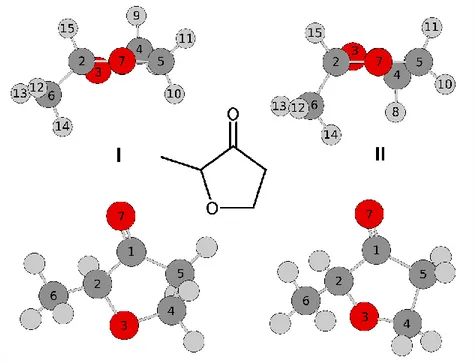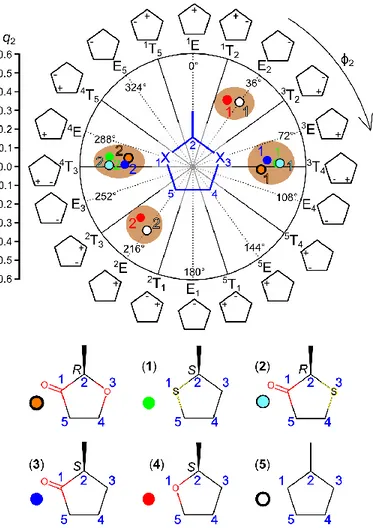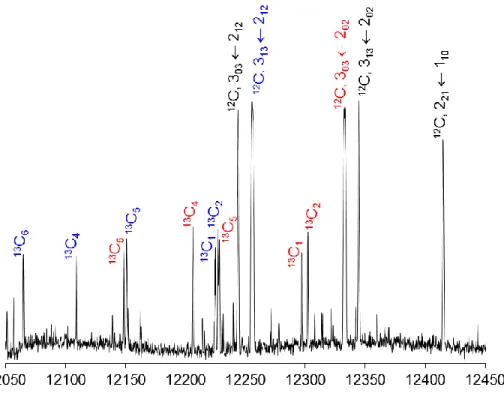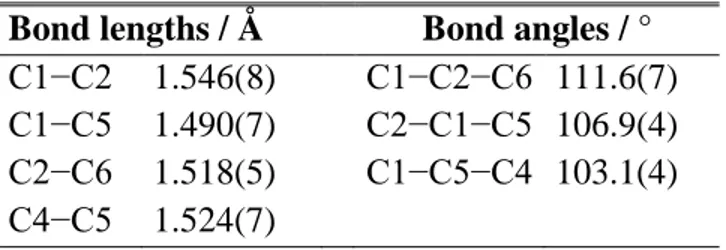HAL Id: hal-03183013
https://hal.u-pec.fr//hal-03183013
Submitted on 26 Mar 2021HAL is a multi-disciplinary open access archive for the deposit and dissemination of sci-entific research documents, whether they are pub-lished or not. The documents may come from teaching and research institutions in France or abroad, or from public or private research centers.
L’archive ouverte pluridisciplinaire HAL, est destinée au dépôt et à la diffusion de documents scientifiques de niveau recherche, publiés ou non, émanant des établissements d’enseignement et de recherche français ou étrangers, des laboratoires publics ou privés.
The smell of coffee: the carbon atom microwave
structure of coffee furanone validated by quantum
chemistry
Vinh Van, Wolfgang Stahl, Minh Tuyen Nguyen, Ha Vinh Lam Nguyen
To cite this version:
Vinh Van, Wolfgang Stahl, Minh Tuyen Nguyen, Ha Vinh Lam Nguyen. The smell of coffee: the carbon atom microwave structure of coffee furanone validated by quantum chemistry. Canadian Journal of Physics, NRC Research Press, 2020, 98 (6), pp.538-542. �10.1139/cjp-2019-0475�. �hal-03183013�
The Smell of Coffee: The Carbon Atom Microwave
Structure of Coffee Furanone Validated by Quantum
Chemistry
Vinh Van,a Wolfgang Stahl,a Minh Tuyen Nguyen,b and Ha Vinh Lam Nguyen*c
a Institute of Physical Chemistry, RWTH Aachen University, Landoltweg 2, D-52074 Aachen,
Germany.
b Department of Chemistry, National University of Civil Engineering, 55 Giai Phong Road,
Hanoi, Vietnam.
c Laboratoire Interuniversitaire des Systèmes Atmosphériques (LISA), CNRS UMR 7583,
Université Paris Est-Créteil, Université de Paris, 61 avenue du Général de Gaulle, F-94010 Créteil cedex, France.
Corresponding Author
ABSTRACT
The rotational spectra of coffee furanone (2-methyltetrahydrofuran-3-one) have been measured in the frequency range from 2.0 to 26.5 GHz using a molecular jet Fourier transform microwave spectrometer. Quantum chemical calculations used for the conformational analysis yielded two stable twist conformers, which were described using the Cremer-Pople notation for five-membered rings. The experimental spectrum of the more stable conformer with the methyl group in equatorial position was assigned and fitted using a rigid rotor model with centrifugal distortion corrections. The spectra of all five 13C-isotopologues could be observed in natural abundance. The carbon atom
structure was experimentally deduced using Kraitchman’s equations and compared with the structure calculated by quantum chemistry.
TOC GRAPHICS
KEYWORDS
1. Introduction
Coffee is a very popular drink in the daily life of millions of people in many countries as a first hot beverage in the morning. Several methods have been investigated and created to produce this drink including different extraction techniques and roasting processes. The coffee aroma is quite complex with more than 800 identified volatile compounds.1 Since the bean roasting and the
brewing of coffee each has many process parameters to create the desired aroma, deep knowledge about the composition of the volatile aroma is necessary.2,3 One of these compounds is the
five-membered heterocyclic molecule 2-methyltetrahydrofuran-3-one, popularly known as coffee furanone, which is also a natural flavor in tomatoes4 and pork.5 In addition, it was identified in the
Maillard reaction which is responsible for the creation of important roasting aromas when food is browned.6
In the present study we investigate the microwave spectrum from a supersonic expansion to understand the gas phase structure of this important coffee aroma compound. The experimental work is supported by quantum chemical calculations, where ab initio structures are taken as references for a comparison of the experimental and calculated molecular parameters.
2. Quantum chemical calculations
Coffee furanone features an ether group in the ring as well as a carbonyl group and a methyl group as substituents (see Figure 1). To sample the conformational landscape of coffee furanone, the two conformers of cyclopentane twist (C2) and bent (Cs)7 were used and modified to generate the
starting geometries. Two CH2 units were exchanged by a carbonyl group and an oxygen atom, and
were subsequently optimized at the MP2/6-311++G(d,p) level of theory using the GAUSSIAN09 program suite.8 From our experiences on other five-membered rings, the MP2/6-311++G(d,p)
level yielded rotational constants close to the experimental values to start the spectral assignment.9,10
Figure 1. The structures of conformer I (left hand side) and II (right hand side) calculated at the
MP2/6-311++G(d,p) level as well as the structural formula of coffee furanone (middle figure). Upper figures: view along the carbonyl bond C1O7. Lower figures: view onto the furan ring. The
energy difference between conformer II and the more stable conformer I is 4.34 kJ·mol─1. The carbon atom C(1) is located behind the oxygen atom O(7).
The geometry optimizations yielded two twist conformers (I and II) as shown in Figure 1. Conformer I with the rotational constants A = 3530 MHz, B = 3119 MHz, and C = 1802 MHz is
MHz). Harmonic frequency calculations at the same level of theory confirmed that they are true minima. Furthermore, various combinations with the HF, B3LYP, MP2, M06-2X, and CCSD methods and different basis sets were used to re-optimize the structures of conformer I and II to check for convergence. The Cartesian coordinates are given in Table S-1; the rotational constants are in Table S-2 in the Supporting Information.
The ring geometries of both conformers can be characterized using the Cremer-Pople puckering parameters11 calculated with the program RING12 to characterize the ring geometries.
There are two parameters for a five-membered ring, the phase angle ϕ2 and the puckering amplitude
q2.11 The calculated geometry of conformer I has the twist structure 3T4 and the methyl substituent
is in inclined orientation with q2 = 0.38 and ϕ2 = 92.3. Conformer II also has a twist structure 4T3
with a little more envelope contribution of the envelope structure 4E and the methyl substituent in
axial orientation with q2 = 0.35 and ϕ2 = 277.6°. The optimized conformers of coffee furanone and
some other related five-membered rings studied in the literature13-16 are illustrated in Figure 2 using
Figure 2. Conformational landscape of coffee furanone (orange dots) and related five-membered
rings using two Cremer-Pople parameters q2 (puckering amplitude) and ϕ2 (phase angle). The
nomenclature is based on the Twist or Envelope geometry and the positions of the atoms which are above (+) and below (−) the ring plane. A planar ring would be located at the center with q2 =
0. Upper figure: 1 and 2 represent the two conformers of each molecule. Lower figure: (1) Methyltetrahydrothiophene (green dots), (2) dihydro-methyl-3-thiophenone (cyan dots), (3) 2-methylcyclopentanone (blue dots), (4) 2-methyltetrahydrofuran (red dots), and (5) methylcyclopentane (white dots).
3. Microwave spectroscopy
Coffee furanone was purchased from TCI Europe, Zwijndrecht, Belgium, with a stated purity of 98 % and used without further purification. The rotational spectra were measured with a molecular jet Fourier transform microwave (FTMW) spectrometer operating in the frequency range 2 26.5 GHz.18 The substance was placed on a piece of a pipe cleaner close to the nozzle under a helium stream at a pressure of approximately 200 kPa. For an overview of the rotational spectra, a survey sprectrum was recorded in the frequency range from 9 to 14 GHz, where overlapping spectra are automatically recorded at a step width of 0.25 MHz with 50 co-added decays per spectrum. Transitions appearing in the scan were subsequently remeasured at higher resolution, where all lines appear as doublets due to the Doppler effect. The line widths range from 12 to 33 kHz, which correspond to a measurement accuracy of about 2 kHz.
We started the spectral assignment with the most stable conformer I. Because the predicted values of the dipole moment components are |µa| = 2.25 D, |µb| = 0.62 D, and |µc| = 0.34 D, we expected strong type, medium b-type, and weaker c-type transitions. At the beginning, the a-type R-branch 303 ← 202 and 313 ← 212, as well as two b-type R-branch transitions 303 ← 212 and
313 ← 202 were considered. As these four transitions form a closed loop, they could be identified
straightforward and all rotational constants were determined. This allowed us to measure further lines up to J = 10 (including c-type transitions) within the frequency range of the spectrometer and to fit all five quartic centrifugal distortion constants. In total, 122 transitions were assigned and fitted with a program written by the authors for Separately Fitting Large Amplitude Motion Species (SFLAMS) to a root mean square (rms) deviation of 2.6 kHz. Coffee furanone can be treated as a rigid rotor, fitting the large amplitude motion torsional symmetry species A with the Hamiltonian only comprising the rotational terms with quartic centrifugal distortion corrections
using Watson’s S reduction. All fitted molecular parameters are summarized in Table 1. The frequency list is given in Table S-3 in the Supporting Information.
The most intense lines in the survey spectrum clearly belong to conformer I. However, about half of the lines with much weaker intensity remain unassigned in the spectrum (see Figure 3). All attempts to assign these lines to conformer II failed. As mentioned, conformer II is 4.34 kJ∙mol−1 higher in energy than conformer I. In our investigations on two other five-membered rings, 2-methyltetrahydrothiophene13 and dihydro-2-methyl-3-thiophenone,14 which possess two
similar twist structures with smaller energy difference, the assignment of the less stable conformer was straightforward. Therefore, we believe that conformer II of coffee furanone is not present under our molecular jet conditions with a very low rotational temperature of less than 2 K.
Table 1. Experimentally deduced molecular parameters of the parent species and the different isotopologues of conformer I of coffee
furanone using the program SFLAMS. The parameters of the parent species (denoted as 12C) are compared with the vibrational ground
state values A0, B0, and C0 calculated by anharmonic frequency calculation at the MP2/6-311++G(d,p) level of theory. For all
isotopologues, the atoms are numbered according to Figure 1.
Par.a Unit 12C MP2 13C(1) 13C(2) 13C(4) 13C(5) 13C(6) A MHz 3539.55633(14) 3500.8 3522.7879(17) 3525.7174(17) 3537.9674(21) 3511.18487(47) 3501.0819(21) B MHz 3111.02316(13) 3093.8 3109.04417(78) 3104.17775(83) 3051.17018(85) 3083.45810(48) 3054.93511(87) C MHz 1796.24912(13) 1786.5 1791.30837(40) 1792.32059(37) 1775.89332(38) 1780.90831(25) 1768.45796(45) DJ kHz 0.2591(26) 0.2113 0.212(31) 0.208(32) 0.215(33) 0.355(81) 0.213(34) DJK kHz –0.0544(24) 0.4977 DK kHz 1.2628(28) 0.5222 1.51(40) 1.63(41) 1.41(48) 1.54(47) d1 kHz –0.08833(46) –0.0804 –0.049(18) –0.052(19) –0.073(19) –0.1434(63) –0.046(19) d2 kHz –0.01874(20) –0.0401 –0.0258(41) rmsb kHz 2.6 3.0 2.5 3.4 1.8 3.3 Nc 122 18 16 19 17 18
Figure 3. A portion of the experimental survey scan of coffee furanone in the frequency range
from 12050 to 12450 MHz. Overlapping spectra are recorded automatically at a step width of 0.25 MHz. For each spectrum, 50 decays were co-added. The intensities are given in a logarithmic scale. Transitions belonging to the parent species (12C) are marked with their respective quantum
numbers 𝐽𝐾𝑎𝐾𝑐. The corresponding 13C isotopologues are color-coded with the carbon position
given as an index (for atom numbering see Figure 1).
We then suspected that the remaining lines might belong to the 13C-isotopologues of
conformer I and calculated the rotational constants of all 13C isotopologues. The four transitions
303 ← 202, 313 ← 212, 303 ← 212 and 313 ← 202 are relatively intense, as visualized in Figure 3, and
could be readily assigned for all five 13C species. More lines were subsequently added to the fits,
and the rotational constants and three quartic centrifugal distortion constants were well-determined. They are also listed in Table 1 along with the parameters of the parent species. In four
13C fits, the d
1 parameter is not well-determined, but neglecting this parameter leads to significant
deviations of the centrifugal distortion values between the 13C isotopic and the parent species. The
assigned transition frequencies are available in Table S-4 in the Supporting Information. To complete the heavy atom structure of coffee furanone, we searched for the two 18O-isotopologues
with a natural abundance of 0.2 %. Five promising transitions of the 18O(3) species could be found
and fitted using three rotational constants as given Table S-5 in the Supporting Information. Though we are confident that the fit is correct because the loop formed by four transitions 303 ←
202, 313 ← 212, 303 ← 212 and 313 ← 202 reflects the experimental accuracy, further transitions are
too weak to be observed. Therefore, the spectra of the 18O-isotopologues are not considered in the
analysis.
The methyl group in coffee furanone undergoes internal rotation with a calculated hindering barrier of 1020 and 1120 cm−1 for conformer I and II, respectively. The highest barrier
for which resolvable torsional splittings have been observed using a
waveguide-FTMW-instrument with a measurement accuracy of 2 kHz (1/10 of the line width at FWHH)is that of
ethylchloride with the value of 1234(31) cm1.19 In ethyl acetate, the barrier height of one methyl
group is 1112.3(37) cm1, resulting in resolvable splittings for some transitions.20 The microwave
spectrum of on hexan-2-one also revealed splittings arising from the methyl torsion with a barrier height of 1016.30(77) cm1.21 However, in the case of coffee furanone, torsional splittings due to
internal rotation are only resolvable for some transitions, and caused line broadening of some other transitions. The experimental barrier height cannot be estimated, because not only the torsional barrier but also further factors like the orientation of the methyl rotor and the molecular mass contribute to the order of magnitude of the splittings. Therefore, the internal rotation effect was not considered in the analysis.
4. Discussion
By comparing the rotational constants obtained from the microwave spectrum of the parent species with the predicted ones listed in Table S-2 in the Supporting Information, we find the best agreement with the results calculated at the MP2/6-31G(d,p) level of theory, as also observed for some other molecules such as phenetol22 and ethyl valerate.23 In general, the molecular geometry of coffee furanone can be predicted well at all levels of theory, including the cost-efficient Hartree-Fock and Truhlar’s M06-2X methods.24 Surprisingly, rotational constants from calculations at the
highest level in use, CCSD/cc-pVTZ, are not in better agreement with the experimental values
as
those predicted at some lower levels. This is probably due to error compensations. It should be mentioned that the experimental constants A0, B0, C0 are deduced from the ground vibrational
spectrum (r0 structure) and cannot be directly compared with the predicted constants Ae, Be, Ce,
which are calculated at equilibrium (re structure). The A0, B0, C0 rotational constants can be
obtained from anharmonic frequency calculations, as given in Table 1 (predicted at the MP2/6-311++G(d,p) level of theory). These values are close to the experimental ones; however, they are not in better agreement than the results from the geometry optimizations at the same level of theory (see Table S-2).
The rotational constants deduced from the spectra of the parent species and the five 13C isotopologues allow us to determine the carbon atom microwave structure of coffee furanone. The position of all carbon atoms (referring to the center of mass of the parent isotopologue) can be calculated from the isotopic shifts with Kraitchman’s equations25 using the program KRA.26 The
distances to the center of mass are then used to calculate the uncertainties using Costain’s rule.27 Because we can only determine the atom coordinates, the signs have been chosen to be the same as those in the coordinates predicted by ab initio. This determined rs structure, with the carbon
atom coordinates given in Table 2, agrees well with both the ground vibrational r0 structure and
the vibrational averaged structure (rz),28 as illustrated in Figure 4. The Cartesian coordinates of the
rz geometry are also indicated in Table S-1 in the Supporting Information. Subsequently, the
experimental bond lengths and angles are calculated with the program and EVAL25 and summarized in Table 3.
Figure 4. Comparison of the carbon atom microwave structure of coffee furanone (rs, in blue) with the carbon atom positions (rz, in gray) of the vibrational averaged structure obtained by anharmonic
frequency calculations. The experimentally deduced bond lengths (in Å) and bond angles (in degree) are given.
Table 2. Carbon atom coordinates of conformer I of coffee furanone experimentally determined
by 13C isotopic substitutions using the program KRA26,27 and compared with those of the vibrational averaged structure (rz) and the equilibrium structure (re).
Experiment rz geometry re geometry
a/Å b/Å c/Å a/Å b/Å c/Å a/Å b/Å c/Å
C1 –0.3116(49) 0.8271(19) –0.060(26) –0.3375 0.8328 –0.0563 –0.3394 0.8256 –0.0547
C2 –0.4517(33) –0.6450(24) 0.3908(39) –0.4453 –0.6649 –0.3952 –0.4387 –0.6656 –0.3925
C4 1.78499(84) –0.2447(62) 0.115(13) 1.7924 –0.2120 –0.1313 1.7848 –0.1995 –0.1371
C5 1.1381(14) 1.0690(14) –0.3058(50) 1.1214 1.0895 0.3261 1.1113 1.0898 0.3305
Table 3. Experimental bond lengths and bond angles of conformer I obtained using the program
EVAL.26
Bond lengths / Å Bond angles / °
C1−C2 1.546(8) C1−C2−C6 111.6(7)
C1−C5 1.490(7) C2−C1−C5 106.9(4)
C2−C6 1.518(5) C1−C5−C4 103.1(4)
C4−C5 1.524(7)
The structures of two twist conformers of coffee furanone obtained by quantum chemistry, one of which was confirmed by the microwave experiments, are very similar to those of other related five-membered rings found in the literature, which also have two stable twist conformers. Figure 2 confirms this observation, where we can recognize that the circles representing stable conformers of 2-methyltetrahydrothiophene (1),13 dihydro-2-methyl-3-thiophenone (2),14
2-methylcyclopentanone (3),15 and methylcyclopentane (5)10 are almost located at the same positions.
This study on coffee furanone again confirms the domination of the twist structure over the
envelope structure, if a carbonyl group is present in the ring. If the carbonyl group is omitted, we
obtain 2-methyltetrahydrofuran (4), and then the envelope structure becomes dominant (see also Figure 2).16
5. Conclusion
The conformational analysis of coffee furanone by quantum chemistry leads to two stable conformers with twist structures. Under supersonic jet conditions, only the most stable conformer is observed in the microwave spectrum. In addition to the parent species, all 13C isotopologues
equations, bond lengths and bond angles between the carbon atoms were calculated with high accuracy.
ASSOCIATED CONTENT
Supporting Information. Nuclear coordinates in the principal inertial axes of conformer I and
II, rotational constants from the basis set variation, frequency lists. ACKNOWLEDGMENT
M.T. Nguyen thanks the Land Nordrhein-Westfalen for financial support for a one-month research stay at the RWTH Aachen University. V.V. gratefully acknowledges the Fonds der Chemischen Industrie (FCI) for a Ph.D. fellowship. Calculations were performed with computing resources granted by JARA-HPC from the RWTH Aachen University under the project jara0124. This work was supported by the Agence Nationale de la Recherche ANR (project ID ANR-18-CE29-0011).
REFERENCES
(1) N. Yang, C. Liu, X. Liu, T. K. Degn, M. Munchow, I. Fisk, Food Chem. 2016, 211, 206– 214.
(2) M. A. Gianturco, A. S. Giammarino, P. Friedel, V. Flanagan, Tetrahedron 1964, 20, 2951– 2961.
(3) L. Maeztu, C. Sanz, S. Andueza, M. Paz de Pena, J. Bello, C. Cid, J. Agric. Food. Chem.
(4) R. G. Buttery, R. M. Seifert, D. G. Guadagni, L. C. Ling, J. Agric. Food. Chem. 1971, 19, 524–529.
(5) D. S. Mottram, J. Sci. Food Agric. 1985, 36, 377–382.
(6) L. J. Farmer, D. S. Mottram, F. B. Whitfield, J. Sci. Food Agric. 1989, 49, 347–368. (7) E. J. Ocola, L. E. Bauman, J. Laane, J. Phys. Chem. A 2011, 115, 6531–6542.
(8) M. J. Frisch, G. W. Trucks, H. B. Schlegel, G. E. Scuseria, M. A. Robb, J. R. Cheeseman, G. Scalmani, V. Barone, B. Mennucci, G. A. Petersson, H. Nakatsuji, M. Caricato, X. Li, H. P. Hratchian, A. F. Izmaylov, J. Bloino, G. Zheng, J. L. Sonnenberg, M. Hada, M. Ehara, K. Toyota, R. Fukuda, J. Hasegawa, M. Ishida, T. Nakajima, Y. Honda, O. Kitao, H. Nakai, T. Vreven, J. A. Montgomery, Jr., J. E. Peralta, F. Ogliaro, M. Bearpark, J. J. Heyd, E. Brothers, K. N. Kudin, V. N. Staroverov, R. Kobayashi, J. Normand, K. Raghavachari, A. Rendell, J. C. Burant, S. S. Iyengar, J. Tomasi, M. Cossi, N. Rega, J. M. Millam, M. Klene, J. E. Knox, J. B. Cross, V. Bakken, C. Adamo, J. Jaramillo, R. Gomperts, R. E. Stratmann, O. Yazyev, A. J. Austin, R. Cammi, C. Pomelli, J. W. Ochterski, R. L. Martin, K. Morokuma, V. G. Zakrzewski, G. A. Voth, P. Salvador, J. J. Dannenberg, S. Dapprich, A. D. Daniels, O. Farkas, J. B. Foresman, J. V. Ortiz, J. Cioslowski, D. J. Fox, Gaussian, Inc., Wallingford CT,
2009.
(9) H. Mouhib, W. Stahl, M. Lüthy, M. Büchel, P. Kraft, Angew. Chem. Int. Ed. 2011, 50, 5576– 5580.
(10) V. Van, W. Stahl, M. Schwell, H. V. L. Nguyen, J. Mol. Struct. 2018, 1156, 348–352. (11) D. Cremer, J. A. Pople, J. Am. Chem. Soc. 1975, 97, 1354–1358.
(12) D. Cremer, Quantum Chem. Program Exchange 1975, 288, 1–8.
(13) V. Van, C. Dindic, W. Stahl, H. V. L. Nguyen, ChemPhysChem 2015, 16, 291–294. (14) H. Mouhib, V. Van, W. Stahl, J. Phys. Chem. A 2013, 117, 6652–6656.
(15) J. L. Alonso, J. C. López, R. M. Villamañán, J. Mol. Spectrosc. 1987, 126, 348−355. (16) V. Van, W. Stahl, H. V. L. Nguyen, J. Mol. Struct. 2016, 1123, 24–29.
(17) C. Altona, M. Sundaralingam, J. Am. Chem. Soc. 1972, 94, 8205–8212. (18) J.-U. Grabow, W. Stahl, H. Dreizler, Rev. Sci. Instrum. 1996, 67, 4072–4084. (19) W. Stahl, H. Dreizler, M. Hayashi, Z. Naturforsch. 1983, 38a, 1010–1014.
(20) D. Jelisavac, D.C. Cortés-Gómez, H. V. L. Nguyen, L. W. Sutikdja, W. Stahl, I. Kleiner, J.
Mol. Spectrosc. 2009, 257, 111-115.
(21) M. Andresen, I. Kleiner, M. Schwell, W. Stahl, H. V. L. Nguyen, ChemPhysChem 2019, 20, 2063–2073.
(22) L. Ferres, W. Stahl, H. V. L. Nguyen, Mol. Phys. 2016, 114, 2788–2793.
(23) H. Mouhib, D. Jelisavac, L. W. Sutikdja, E. Isaak, W. Stahl, J. Phys. Chem. A, 2011, 115, 118−122.
(24) Y. Zhao, D.G. Truhlar, Theor. Chem. Acc. 2008, 120, 215−241. (25) J. Kraitchman, Am. J. Phys. 1953, 21, 17−24.
(26) Z. Kisiel, PROSPE-Programs for ROtational SPEctroscopy, available at http://info.ifpan.edu.pl/∼kisiel/prospe.htm.
(27) C. C. Costain, Trans. Am. Crystallogr. Assoc. 1966, 2, 157−164.
(28) R. M. Spycher, D. Petitprez, F. L. Bettens, A. Bauder, J. Phys. Chem. 1994, 98, 11863−11869.





